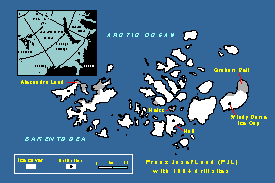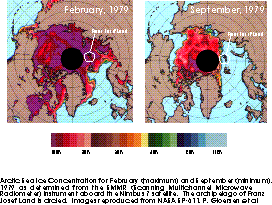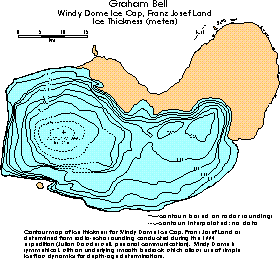
Windy Dome Weather Station
Ice Core Drilling
 In the spring of 1997, a joint team of researchers from the Russian Academy
of Sciences (Moscow) and The Ohio State University (Department of Geological
Sciences and Byrd Polar Research Center) began an exciting deep ice drilling
program in the high Russian Arctic, on the summit of Kupol Vyetreniy (Windy
Dome), Graham Bell Island (81oN, 64oE). This ice
dome has a very symmetrical shape, maximum ice thickness of about 500-550m,
and a peak elevation of about 580m. The University of Massachusetts Climatology
Laboratory is collaborating in this effort by providing and supporting
an automated weather station at the site. Funding is being provided by
NASA.
In the spring of 1997, a joint team of researchers from the Russian Academy
of Sciences (Moscow) and The Ohio State University (Department of Geological
Sciences and Byrd Polar Research Center) began an exciting deep ice drilling
program in the high Russian Arctic, on the summit of Kupol Vyetreniy (Windy
Dome), Graham Bell Island (81oN, 64oE). This ice
dome has a very symmetrical shape, maximum ice thickness of about 500-550m,
and a peak elevation of about 580m. The University of Massachusetts Climatology
Laboratory is collaborating in this effort by providing and supporting
an automated weather station at the site. Funding is being provided by
NASA.
The archipelago of Franz Josef Land, on the northern rim of the
continental shelf that underlies the Barents Sea, is the northernmost land
mass in the Eastern Hemisphere. Here, the climate is influenced greatly
by the intrusion of Atlantic-derived cyclonic systems that feed moisture
into the region, and as a consequence, Franz Josef Land has unusually mild
summers for its latitude. In the polar night (wintertime), however, the
conditions become extremely harsh, with average temperatures diving down
to -25 to -30oC. This means that Franz Josef Land is at an excellent location for studying changes in sea ice cover in the Arctic, since it
lies in the region between the modern-day seasonal maximum (February) and
minimum (September) sea ice modern-day seasonal maximum (February) and
minimum (September) sea ice cover. Satellite measurements of sea ice extent
are being used in conjunction with stratigraphic profiles of sea-salt aerosols
(Cl-, SO42-) from short cores (up to 24m) drilled in 1994 to develop a
transfer function that will allow the ice core sea-salt record to be used
as a proxy for changing sea ice cover in the surrounding Barents Sea.
 Windy Dome is likely to contain a record of local and regional conditions
extending back to at least the early Holocene (8,000 to 10,000 years),
and it is hoped that glacial stage ice is archived there as well. During
the 1997 field season a 315 meter core and a 36 meter ice core were successfully
recovered. These will be analyzed over the next few years.
Windy Dome is likely to contain a record of local and regional conditions
extending back to at least the early Holocene (8,000 to 10,000 years),
and it is hoped that glacial stage ice is archived there as well. During
the 1997 field season a 315 meter core and a 36 meter ice core were successfully
recovered. These will be analyzed over the next few years.

Images from the 1997 coring expedition (Victor S. Zagorodnov photos):
Windy Dome automated weather station (1)
Windy Dome automated weather station
(2)
OSU/RAS camp on Graham Bell Island
 In the spring of 1997, a joint team of researchers from the Russian Academy
of Sciences (Moscow) and The Ohio State University (Department of Geological
Sciences and Byrd Polar Research Center) began an exciting deep ice drilling
program in the high Russian Arctic, on the summit of Kupol Vyetreniy (Windy
Dome), Graham Bell Island (81oN, 64oE). This ice
dome has a very symmetrical shape, maximum ice thickness of about 500-550m,
and a peak elevation of about 580m. The University of Massachusetts Climatology
Laboratory is collaborating in this effort by providing and supporting
an automated weather station at the site. Funding is being provided by
NASA.
In the spring of 1997, a joint team of researchers from the Russian Academy
of Sciences (Moscow) and The Ohio State University (Department of Geological
Sciences and Byrd Polar Research Center) began an exciting deep ice drilling
program in the high Russian Arctic, on the summit of Kupol Vyetreniy (Windy
Dome), Graham Bell Island (81oN, 64oE). This ice
dome has a very symmetrical shape, maximum ice thickness of about 500-550m,
and a peak elevation of about 580m. The University of Massachusetts Climatology
Laboratory is collaborating in this effort by providing and supporting
an automated weather station at the site. Funding is being provided by
NASA.


